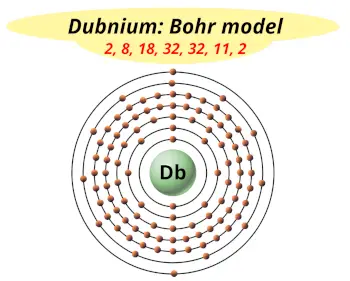Math Is Fun Forum
You are not logged in.
- Topics: Active | Unanswered
- Index
- » Science HQ
- » Dubnium
Pages: 1
#1 2025-10-20 19:29:57
- Jai Ganesh
- Administrator

- Registered: 2005-06-28
- Posts: 52,661
Dubnium
Dubnium
Gist
Dubnium (Db) is a synthetic, highly radioactive chemical element with atomic number 105. It is a transuranic element, meaning it does not occur naturally and must be produced in a laboratory by bombarding other elements. The most stable known isotope, (268Db), has a half-life of approximately 16 to 28 hours. Due to its radioactivity and extremely short half-life, it has no practical uses and is only used in scientific research.
It has never been found naturally and only a small number of atoms have been produced in laboratories. Its chemistry and appearance are not known with any certainty, although the chemistry is believed to be similar to tantalum. Dubnium is too rare to have any commercial or industrial application.
Summary
Dubnium is a synthetic chemical element; it has symbol Db and atomic number 105. It is highly radioactive: the most stable known isotope, dubnium-268, has a half-life of about 16 hours. This greatly limits extended research on the element.
Dubnium does not occur naturally on Earth and is produced artificially. The Soviet Joint Institute for Nuclear Research (JINR) claimed the first discovery of the element in 1968, followed by the American Lawrence Berkeley Laboratory in 1970. Both teams proposed their names for the new element and used them without formal approval. The long-standing dispute was resolved in 1993 by an official investigation of the discovery claims by the Transfermium Working Group, formed by the International Union of Pure and Applied Chemistry and the International Union of Pure and Applied Physics, resulting in credit for the discovery being officially shared between both teams. The element was formally named dubnium in 1997 after the town of Dubna, the site of the JINR.
Theoretical research establishes dubnium as a member of group 5 in the 6d series of transition metals, placing it under vanadium, niobium, and tantalum. Dubnium should share most properties, such as its valence electron configuration and having a dominant +5 oxidation state, with the other group 5 elements, with a few anomalies due to relativistic effects. A limited investigation of dubnium chemistry has confirmed this.
Details
Dubnium (Db) is an artificially produced radioactive transuranium element in Group Vb of the periodic table, atomic number 105. The discovery of dubnium (element 105), like that of rutherfordium (element 104), has been a matter of dispute between Soviet and American scientists. The Soviets may have synthesized a few atoms of element 105 in 1967 at the Joint Institute for Nuclear Research in Dubna, Russia, U.S.S.R., by bombarding americium-243 with neon-22 ions, producing isotopes of element 105 having mass numbers of 260 and 261 and half-lives of 0.1 second and 3 seconds, respectively. Because the Dubna group did not propose a name for the element at the time they announced their preliminary data—a practice that has been customary following the discovery of a new element—it was surmised by American scientists that the Soviets did not have strong experimental evidence to substantiate their claims. Soviet scientists contended, however, that they did not propose a name in 1967 because they preferred to accumulate more data about the chemical and physical properties of the element before doing so. After completing further experiments, they proposed the name nielsbohrium.
In 1970 a group of investigators at the Lawrence Radiation Laboratory of the University of California at Berkeley announced that they had synthesized isotope 260 of element 105, whereupon they proposed the name hahnium for the element, in honour of Otto Hahn, the discoverer of nuclear fission. The American team could not duplicate the Soviet experiment; but, when its members bombarded californium-249 with the nuclei of nitrogen-15 atoms, they produced “hahnium-260,” which had a half-life of about 1.6 seconds. As further evidence of their discovery, the scientists at Berkeley measured the amount of energy emitted by “hahnium-260” as it decayed, as well as the elements produced in the process; these characteristics were quite different from those of previously known elements in the periodic system. The International Union of Pure and Applied Chemistry ultimately determined that the element be named dubnium.
Element Properties
atomic number : 105
mass of most stable isotope : 260.
Additional Information:
Appearance
A highly radioactive metal, of which only a few atoms have ever been made.
Uses
At present, it is only used in research.
Biological role
Dubnium has no known biological role.
Natural abundance
Dubnium does not occur naturally. It is a transuranium element created by bombarding californium-249 with nitrogen-15 nuclei.

It appears to me that if one wants to make progress in mathematics, one should study the masters and not the pupils. - Niels Henrik Abel.
Nothing is better than reading and gaining more and more knowledge - Stephen William Hawking.
Online
Pages: 1
- Index
- » Science HQ
- » Dubnium